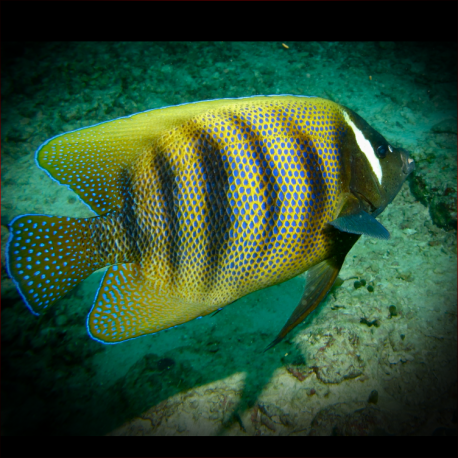More info
Datasheet
| Minimum Tank Size | 831 litres / 219.53 US gallons |
| Maximum Size | 15.2cm / 5.98inches |
| Reef Compatible | With Caution |
| Temperament | Semi-aggressive |
| Care Description | Moderate |
| Specific Gravity | 1.020-1.025 |
| Carbonate Hardness | 8-12 |
| pH | 8.1-8.4 |
General Description
The Six Bar Angelfish, also known as the Sixbanded Angelfish or Six Striped Angelfish, boasts a predominantly pale-tan body adorned with five dark brown stripes. A sixth stripe, white in color, rests just behind the eye. Its body is peppered with dark blue polka-dots, while vibrant sapphire-blue dots embellish the caudal fin and rear section of the anal fin. Divers and aquarists often note that these angelfish emit grunting sounds as a warning when approached.
Aquarium Suitability
This large fish, reaching up to 15.2 cm in size, necessitates a spacious environment, ideally a 220-gallon tank or larger. The setup should offer numerous hiding spots, with ample live rock contributing to the creation of a suitable habitat. However, due to its tendency to nip at stony and soft corals as well as clam mantles, the Six Bar Angelfish is not recommended for reef aquariums.
Care and Hardiness
Considered moderately demanding, the Six Bar Angelfish's diet should consist of Spirulina, marine algae, high-quality angelfish preparations, mysis or frozen shrimp, and other meaty items. Feeding it at least three times a day is recommended to maintain its health and vitality.
Reef Suitability
While the Six Bar Angelfish can be kept in a reef tank, caution is advised due to its propensity for picking at corals and clam mantles.
Aquarium Setup
For optimal care of the Six Bar Angelfish, provide a tank with a capacity of at least 831 liters, abundant hiding places, and a diverse diet to mimic its natural feeding habits. Maintaining water conditions within the range of pH 8.1-8.4, dKH 8-12, and specific gravity of 1.020-1.025 is crucial for its well-being.
Behaviour
This species exhibits a semi-aggressive temperament, and careful consideration should be given when selecting tankmates to ensure compatibility.
Feeding and Diet
Being an omnivore, the Six Bar Angelfish should be fed a varied diet consisting of plant matter, protein-rich foods, and supplements to meet its nutritional requirements.
Dimorphism
The Six Bar Angelfish is hermaphroditic, making it challenging to differentiate between males and females based on coloration alone. Breeding this species in captivity is also known to be difficult due to these factors.

